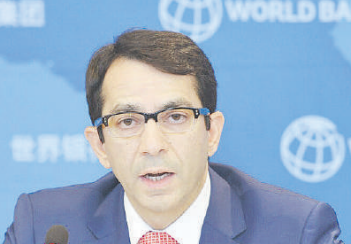 Ayhan Kose, the World Bank’s deputy chief Economist and director of the Prospects Group /(X)
Ayhan Kose, the World Bank’s deputy chief Economist and director of the Prospects Group /(X)
The World Bank has downgraded Kenya’s economic growth even as it warns that growing trade tensions and policy uncertainty are expected to slow global growth this year to its slowest pace since 2008.
In its June update, the global lender forecasts Kenya's GDP growth for 2025 to be 4.5 per cent, marking a decline from the 4.7 per cent growth recorded last year.
The projection also represents a significant cut from its earlier forecast of five per cent growth made in January.
It attributes the downward adjustment largely to persistent food inflation, which continues to exert pressure on household budgets and the broader economy.
“Droughts in Eastern Africa, especially in Kenya, Rwanda, and Uganda, have led to a sustained decline in agricultural conditions and crop yields, increasing pressure on food prices.”
Looking ahead, the lender forecasts Kenya’s economic growth to bounce back to 4.9 per cent in 2026.
However, this forecast remains 0.2 percentage points below the January projection for 2026, reflecting ongoing vulnerabilities in the economy.
Regionally, growth in Sub-Saharan Africa (SSA) is forecast to edge up from 3.5 per cent in 2024 to 3.7 per cent this year, and then average 4.2 per cent in 2026-27.
However, the forecast is generally considered weak.
According to the World Bank’s latest Global Economic Prospects report, the turmoil has cut growth forecasts in nearly 70 per cent of all economies, across all regions and income groups, including Kenya, with businesses expected to slump, job creation to slow, and the cost of living likely to shoot.
Global growth is projected to slow to 2.3 per cent in 2025, nearly half a percentage point lower than the rate that had been expected at the start of the year.
The lender of last resort has, however, ruled out a recession. Nevertheless, if forecasts for the next two years materialise, average global growth in the first seven years of the 2020s will be the slowest of any decade since the 1960s.
Indermit Gill, the World Bank Group’s chief Economist and Senior Vice President for Development Economics, says that the developing world is becoming a development-free zone.
“It has been advertising itself for more than a decade. Growth in developing economies has ratcheted down for three decades—from six per cent annually in the 2000s to five per cent in the 2010s—to less than four per cent in the 2020s."
Gill adds that it tracks the trajectory of growth in global trade, which has fallen from an average of five per cent in the 2000s to about 4.5 per cent in the 2010s, to less than three per cent in the 2020s. "Investment growth has also slowed, but debt has climbed to record levels.”
It further shows that growth is expected to slow in nearly 60 per cent of all developing economies this year, averaging 3.8 per cent in 2025 before edging up to an average of 3.9 per cent over 2026 and 2027. That is more than a percentage point lower than the average of the 2010s.
Low-income countries are expected to grow 5.3 per cent this year—a downgrade of 0.4 percentage point from the forecast at the start of 2025.
Tariff increases and tight labour markets are also exerting upward pressure on global inflation, which, at a projected average of 2.9 per cent in 2025, remains above pre-pandemic levels.
Slowing growth will impede developing economies in their efforts to spur job creation, reduce extreme poverty, and close per capita income gaps with advanced economies.
Per capita income growth in developing economies is projected to be 2.9 percent in 2025, 1.1 percentage points below the average between 2000 and 2019. Assuming developing economies other than China can sustain an overall GDP growth of 4 percent—the rate forecast for 2027—it would take them about two decades to return to their pre-pandemic trajectory concerning economic output.
Global growth could rebound faster than expected if major economies can mitigate trade tensions, which would reduce overall policy uncertainty and financial volatility. The analysis finds that if today’s trade disputes were resolved with agreements that halve tariffs relative to their levels in late May, global growth would be 0.2 percentage points stronger on average throughout 2025 and 2026.
“Emerging-market
and developing economies reaped the rewards of trade integration but
now find themselves on the frontlines of a global trade conflict,” said Ayhan Kose, the World Bank’s deputy chief Economist and director of the Prospects Group
“The smartest way to respond is to redouble efforts on integration with new partners, advance pro-growth reforms, and shore up fiscal resilience to weather the storm. With trade barriers rising and uncertainty mounting, renewed global dialogue and cooperation can chart a more stable and prosperous path forward.”
The report argues that in the face of rising trade barriers, developing economies should seek to liberalize more broadly by pursuing strategic trade and investment partnerships with other economies and diversifying trade, including through regional agreements.
Given limited government resources and rising development needs, policymakers should focus on mobilizing domestic revenues, prioritizing fiscal spending for the most vulnerable households, and strengthening fiscal frameworks.
To accelerate economic growth, the global lender says that countries will need to improve business climates and promote productive employment by equipping workers with the necessary skills and creating the conditions for labor markets to efficiently match workers and firms.











